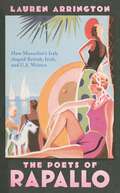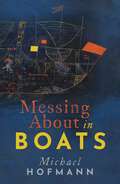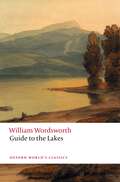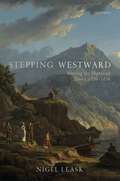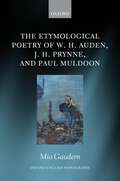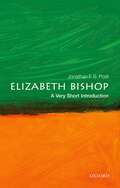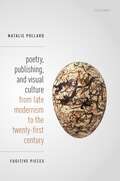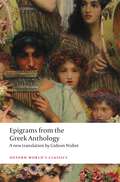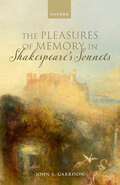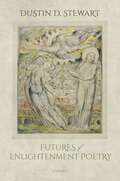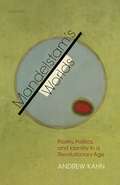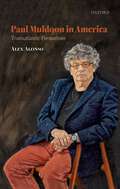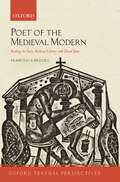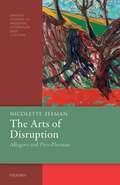- Table View
- List View
The Poets of Rapallo: How Mussolini's Italy shaped British, Irish, and U.S. Writers
by Lauren ArringtonA new story about the relationships between major twentieth-century English-language poets. Why did poets from the United States, Britain, and Ireland gather in a small town in Italy during the early years of Mussolini's regime? These writers were—or became—some of the most famous poets of the twentieth century. What brought them together, and what did they hope to achieve? The Poets of Rapallo is about the conversations, collaborations, and disagreements among Ezra and Dorothy Pound, W.B. and George Yeats, Richard Aldington and Brigit Patmore, Thomas MacGreevy, Louis Zukofsky, and Basil Bunting. Drawing on their correspondence, diaries, drafts of poems, sketches, and photographs, this book shows how the backdrop of the Italian fascist regime is essential to their writing about their home countries and their ideas about modern art and poetry. It also explores their interconnectedness as poets and shows how these connections were erased as their work was polished for publication. Focusing on the years between 1928 and 1935, when Pound and Yeats hosted an array of visiting writers, this book shows how the literary culture of Rapallo forged the lifelong friendships of Richard Aldington and Thomas MacGreevy—both veterans of the First World War—and of Louis Zukofsky and Basil Bunting, who imagined a new kind of "democratic" poetry for the twentieth century. In the wake of the Second World War, these four poets all downplayed their relationship to Ezra Pound and avoided discussing how important Rapallo was to their development as poets. But how did these "democratic" poets respond to the fascist context in which they worked during their time in Rapallo? The Poets of Rapallo discusses their collaboration with Pound, their awareness of the rising tide of fascism, and even—in some cases—their complicity in the activities of the fascist regime. The Poets of Rapallo charts the new direction for modernist writing that these writers imagined, and in the process, it exposes the dark underbelly of some of the most lauded poetry in the English language.
Messing About in Boats (Clarendon Lectures in English)
by Michael HofmannWritten by the eminent poet Michael Hofmann, this approachable and companionable book offers readings of four poems on the subject of boats. Based on Michael Hofmann's Clarendon lectures, this volume offers readings of four poems in German, French, Italian, and English, by Rainer Maria Rilke, Arthur Rimbaud, Eugenio Montale, and Karen Solie. All four poems are on the subject of boats: 'Emigrant Ship', the 'Bateau Ivre', 'Boats on the Marne', and 'The World'. The volume suggests an affinity between boats and poems, offers a partial lineage of boats in poems, and pursues four variant destinies: the boat that stays in port, the boat that gives itself to the world, the boat that is washed away down the river, and the one that goes manically and hubristically on forever. The volume retains the style of lectures and has an improvisational character, with the same fire and detail as the things it is about. It is written with a sense of fun, of revelation, and in a spirit of respect and attention.
Messing About in Boats (Clarendon Lectures in English)
by Michael HofmannWritten by the eminent poet Michael Hofmann, this approachable and companionable book offers readings of four poems on the subject of boats. Based on Michael Hofmann's Clarendon lectures, this volume offers readings of four poems in German, French, Italian, and English, by Rainer Maria Rilke, Arthur Rimbaud, Eugenio Montale, and Karen Solie. All four poems are on the subject of boats: 'Emigrant Ship', the 'Bateau Ivre', 'Boats on the Marne', and 'The World'. The volume suggests an affinity between boats and poems, offers a partial lineage of boats in poems, and pursues four variant destinies: the boat that stays in port, the boat that gives itself to the world, the boat that is washed away down the river, and the one that goes manically and hubristically on forever. The volume retains the style of lectures and has an improvisational character, with the same fire and detail as the things it is about. It is written with a sense of fun, of revelation, and in a spirit of respect and attention.
Guide to the Lakes (Oxford World's Classics)
by William WordsworthWilliam Wordsworth's Guide to the Lakes gives a first-hand account of his feelings about the unique countryside that was the source of his inspiration. He addresses concerns that are relevant today, such as how the growing number of visitors, and the money they might bring, would affect such a small and vulnerable landscape. It is now understood that Wordsworth's notion of the Lake District as 'a sort of national property, in which every man has a right and interest who has an eye to perceive and a heart to enjoy', expressed in his Guide, gave a rationale for the foundation of the National Trust in 1895 and the establishment of the Lake District National Park in 1951. Furthermore, the 2017 nomination document for the Lake District as a World Heritage site quotes this phrase in recognition of Wordsworth's contribution to the idea that 'landscape has a value, and that everyone has a right to appreciate and enjoy it'. We can now see how Wordsworth's Guide has had a far-reaching influence on the modern concept of legally-protected landscape. First published in 1810 and repeatedly revised by its author over the ensuing twenty-five years, William Wordsworth's Guide to the Lakes has long been considered a crucial text for scholars of Romantic-era aesthetics, ecology, travel writing, and tourism.
Guide to the Lakes: With Mr. Wordsworth's Description Of The Scenery Of The Country, Etc. And Five Letters On The Geology Of The Lake District (Oxford World's Classics)
by William WordsworthWilliam Wordsworth's Guide to the Lakes gives a first-hand account of his feelings about the unique countryside that was the source of his inspiration. He addresses concerns that are relevant today, such as how the growing number of visitors, and the money they might bring, would affect such a small and vulnerable landscape. It is now understood that Wordsworth's notion of the Lake District as 'a sort of national property, in which every man has a right and interest who has an eye to perceive and a heart to enjoy', expressed in his Guide, gave a rationale for the foundation of the National Trust in 1895 and the establishment of the Lake District National Park in 1951. Furthermore, the 2017 nomination document for the Lake District as a World Heritage site quotes this phrase in recognition of Wordsworth's contribution to the idea that 'landscape has a value, and that everyone has a right to appreciate and enjoy it'. We can now see how Wordsworth's Guide has had a far-reaching influence on the modern concept of legally-protected landscape. First published in 1810 and repeatedly revised by its author over the ensuing twenty-five years, William Wordsworth's Guide to the Lakes has long been considered a crucial text for scholars of Romantic-era aesthetics, ecology, travel writing, and tourism.
Stepping Westward: Writing the Highland Tour c. 1720-1830
by Nigel LeaskStepping Westward is the first book dedicated to the literature of the Scottish Highland tour of 1720-1830, a major cultural phenomenon that attracted writers and artists like Pennant, Johnson and Boswell, William and Dorothy Wordsworth, Coleridge, Scott, Hogg, Keats, Daniell, and Turner, as well as numerous less celebrated travellers and tourists. Addressing more than a century's worth of literary and visual representations of the Highlands, the book casts new light on how the tour developed a modern literature of place, acting as a catalyst for thinking about improvement, landscape, and the shaping of British, Scottish, and Gaelic identities. It pays attention to the relationship between travellers and the native Gaels, whose world was plunged into crisis by rapid and forced social change. At the book's core lie the best-selling tours of Pennant and Dr Johnson, associated with attempts to 'improve' the intractable Gaidhealtachd in the wake of Culloden. Alongside the Ossian craze and Gilpin's picturesque, their books stimulated a wave of 'home tours' from the 1770s through the romantic period, including writing by women like Sarah Murray and Dorothy Wordsworth. The incidence of published Highland Tours (many lavishly illustrated), peaked around 1800, but as the genre reached exhaustion, the 'romantic Highlands' were reinvented in Scott's poems and novels, coinciding with steam boats and mass tourism, but also rack-renting, sheep clearance, and emigration.
Stepping Westward: Writing the Highland Tour c. 1720-1830
by Nigel LeaskStepping Westward is the first book dedicated to the literature of the Scottish Highland tour of 1720-1830, a major cultural phenomenon that attracted writers and artists like Pennant, Johnson and Boswell, William and Dorothy Wordsworth, Coleridge, Scott, Hogg, Keats, Daniell, and Turner, as well as numerous less celebrated travellers and tourists. Addressing more than a century's worth of literary and visual representations of the Highlands, the book casts new light on how the tour developed a modern literature of place, acting as a catalyst for thinking about improvement, landscape, and the shaping of British, Scottish, and Gaelic identities. It pays attention to the relationship between travellers and the native Gaels, whose world was plunged into crisis by rapid and forced social change. At the book's core lie the best-selling tours of Pennant and Dr Johnson, associated with attempts to 'improve' the intractable Gaidhealtachd in the wake of Culloden. Alongside the Ossian craze and Gilpin's picturesque, their books stimulated a wave of 'home tours' from the 1770s through the romantic period, including writing by women like Sarah Murray and Dorothy Wordsworth. The incidence of published Highland Tours (many lavishly illustrated), peaked around 1800, but as the genre reached exhaustion, the 'romantic Highlands' were reinvented in Scott's poems and novels, coinciding with steam boats and mass tourism, but also rack-renting, sheep clearance, and emigration.
The Etymological Poetry of W. H. Auden, J. H. Prynne, and Paul Muldoon (Oxford English Monographs)
by Mia GaudernThis book defines, analyses, and theorises a late modern 'etymological poetry' that is alive to the past lives of its words, and probes the possible significance of them both explicitly and implicitly. Close readings of poetry and criticism by Auden, Prynne, and Muldoon investigate the implications of their etymological perspectives for the way their language establishes relationships between people, and between people and the world. These twin functions of communication and representation are shown to be central to the critical reception of etymological poetry, which is a category of 'difficult' poetry. However resonant poetic etymologising may be, critics warn that it shows the poet's natural interest in language degenerating into an unhealthy obsession with the dictionary. It is unavoidably pedantic, in the post-Saussurean era, to entertain the idea that a word's history might have any relevance to its current use. As such, etymological poetry elicits the closest of close readings, thus encouraging readers to reflect not only on its own pedantry, obscurity, and virtuosity, but also on how these qualities function in criticism. As well as presenting a new way of reading three very different late modern poet-critics, this book addresses an understudied aspect of the relationship between poetry and criticism. Its findings are situated in the context of literary debates about difficulty and diction, and in larger cultural conversations about the workings of language as a historical event.
The Etymological Poetry of W. H. Auden, J. H. Prynne, and Paul Muldoon (Oxford English Monographs)
by Mia GaudernThis book defines, analyses, and theorises a late modern 'etymological poetry' that is alive to the past lives of its words, and probes the possible significance of them both explicitly and implicitly. Close readings of poetry and criticism by Auden, Prynne, and Muldoon investigate the implications of their etymological perspectives for the way their language establishes relationships between people, and between people and the world. These twin functions of communication and representation are shown to be central to the critical reception of etymological poetry, which is a category of 'difficult' poetry. However resonant poetic etymologising may be, critics warn that it shows the poet's natural interest in language degenerating into an unhealthy obsession with the dictionary. It is unavoidably pedantic, in the post-Saussurean era, to entertain the idea that a word's history might have any relevance to its current use. As such, etymological poetry elicits the closest of close readings, thus encouraging readers to reflect not only on its own pedantry, obscurity, and virtuosity, but also on how these qualities function in criticism. As well as presenting a new way of reading three very different late modern poet-critics, this book addresses an understudied aspect of the relationship between poetry and criticism. Its findings are situated in the context of literary debates about difficulty and diction, and in larger cultural conversations about the workings of language as a historical event.
Elizabeth Bishop: A Very Short Introduction (Very Short Introductions)
by Jonathan F. PostVery Short Introductions: Brilliant, Sharp, Inspiring Elizabeth Bishop has been described as the 'best-loved' poet in English of the second half of the twentieth century. This Very Short Introduction explores the 90 or so published poems that are at the core of her remarkable canon of verse. Drawing on biographical and critical material, Jonathan Post also makes frequent use of Bishop's letters and commentary by fellow poets, including Marianne Moore, Robert Lowell, and James Merrill to illuminate her writing and contemporary literary landscape. Throughout, Post places Bishop's lyric poetry within the context of her life and aesthetic values, showing how these shaped her work. The book covers a wide range of core themes present in her poetry, including her powerful use of description, the environment, balance, and ideas of love and loss, as well as looking at Bishop's interest in the visual arts. ABOUT THE SERIES: The Very Short Introductions series from Oxford University Press contains hundreds of titles in almost every subject area. These pocket-sized books are the perfect way to get ahead in a new subject quickly. Our expert authors combine facts, analysis, perspective, new ideas, and enthusiasm to make interesting and challenging topics highly readable.
Elizabeth Bishop: A Very Short Introduction (Very Short Introductions)
by Jonathan F. PostVery Short Introductions: Brilliant, Sharp, Inspiring Elizabeth Bishop has been described as the 'best-loved' poet in English of the second half of the twentieth century. This Very Short Introduction explores the 90 or so published poems that are at the core of her remarkable canon of verse. Drawing on biographical and critical material, Jonathan Post also makes frequent use of Bishop's letters and commentary by fellow poets, including Marianne Moore, Robert Lowell, and James Merrill to illuminate her writing and contemporary literary landscape. Throughout, Post places Bishop's lyric poetry within the context of her life and aesthetic values, showing how these shaped her work. The book covers a wide range of core themes present in her poetry, including her powerful use of description, the environment, balance, and ideas of love and loss, as well as looking at Bishop's interest in the visual arts. ABOUT THE SERIES: The Very Short Introductions series from Oxford University Press contains hundreds of titles in almost every subject area. These pocket-sized books are the perfect way to get ahead in a new subject quickly. Our expert authors combine facts, analysis, perspective, new ideas, and enthusiasm to make interesting and challenging topics highly readable.
Poetry, Publishing, and Visual Culture from Late Modernism to the Twenty-first Century: Fugitive Pieces
by Natalie PollardThis is a book about contemporary literary and artistic entanglements: word and image, media and materiality, inscription and illustration. It proposes a vulnerable, fugitive mode of reading poetry, which defies disciplinary categorisations, embracing the open-endedness and provisionality of forms. This manifests itself interactively in the six case studies, which have been chosen for their distinctness and diversity across the long twentieth century: the book begins with the early twentieth-century work of writer and artist Djuna Barnes, exploring her re-animation of sculptural and dramatic sources. It then turns to the late modernist artist and poet David Jones considering his use of the graphic and plastic arts in The Anathemata, and next, to the underappreciated mid-century poet F.T. Prince, whose work uncannily re-activates Michelangelo's poetry and sculpture. The second half of the book explores the collaborations of the canonical poet Ted Hughes with the publisher and artist Leonard Baskin during the 1970s; the innovative late twentieth-century poetry of Denise Riley who uses page space and embodied sound as a form of address; and, finally, the contemporary poet Paul Muldoon who has collaborated with photographers and artists, as well as ventriloquising nonhuman phenomena. The resulting unique study offers contemporary writers and readers a new understanding of literary, artistic, and nonhuman practices and shows the cultural importance of engaging with their messy co-dependencies. The book challenges critical methodologies that make a sharp division between the textual work and the extra-literary, and raises urgent questions about the status and autonomy of art and its social role.
Poetry, Publishing, and Visual Culture from Late Modernism to the Twenty-first Century: Fugitive Pieces
by Natalie PollardThis is a book about contemporary literary and artistic entanglements: word and image, media and materiality, inscription and illustration. It proposes a vulnerable, fugitive mode of reading poetry, which defies disciplinary categorisations, embracing the open-endedness and provisionality of forms. This manifests itself interactively in the six case studies, which have been chosen for their distinctness and diversity across the long twentieth century: the book begins with the early twentieth-century work of writer and artist Djuna Barnes, exploring her re-animation of sculptural and dramatic sources. It then turns to the late modernist artist and poet David Jones considering his use of the graphic and plastic arts in The Anathemata, and next, to the underappreciated mid-century poet F.T. Prince, whose work uncannily re-activates Michelangelo's poetry and sculpture. The second half of the book explores the collaborations of the canonical poet Ted Hughes with the publisher and artist Leonard Baskin during the 1970s; the innovative late twentieth-century poetry of Denise Riley who uses page space and embodied sound as a form of address; and, finally, the contemporary poet Paul Muldoon who has collaborated with photographers and artists, as well as ventriloquising nonhuman phenomena. The resulting unique study offers contemporary writers and readers a new understanding of literary, artistic, and nonhuman practices and shows the cultural importance of engaging with their messy co-dependencies. The book challenges critical methodologies that make a sharp division between the textual work and the extra-literary, and raises urgent questions about the status and autonomy of art and its social role.
Epigrams from the Greek Anthology (Oxford World's Classics)
by Gideon NisbetLush Diodorus sets the lads on fire, But now another has him in his net - Timarion, the boy with wanton eyes . . . Meleager, AP 12.109 Encompassing four thousand short poems and more, the ramshackle classic we call the Greek Anthology gathers up a millennium of snapshots from ancient daily life. Its influence echoes not merely in the classic tradition of the English epigram (Pope, Dryden) but in Rudyard Kipling, Ezra Pound, Virgina Woolf, T. S. Eliot, H.D., and the poets of the First World War. Its variety is almost infinite. Victorious armies, ruined cities, and Olympic champions share space with lovers' quarrels and laments for the untimely dead - but also with jokes and riddles, art appreciation, potted biographies of authors, and scenes from country life and the workplace. This selection of more than 600 epigrams in verse is the first major translation from the Greek Anthology in nearly a century. Each of the Anthology's books of epigrams is represented here, in manuscript order, and with extensive notes on the history and myth that lie behind them.
Epigrams from the Greek Anthology (Oxford World's Classics)
by Gideon NisbetLush Diodorus sets the lads on fire, But now another has him in his net - Timarion, the boy with wanton eyes . . . Meleager, AP 12.109 Encompassing four thousand short poems and more, the ramshackle classic we call the Greek Anthology gathers up a millennium of snapshots from ancient daily life. Its influence echoes not merely in the classic tradition of the English epigram (Pope, Dryden) but in Rudyard Kipling, Ezra Pound, Virgina Woolf, T. S. Eliot, H.D., and the poets of the First World War. Its variety is almost infinite. Victorious armies, ruined cities, and Olympic champions share space with lovers' quarrels and laments for the untimely dead - but also with jokes and riddles, art appreciation, potted biographies of authors, and scenes from country life and the workplace. This selection of more than 600 epigrams in verse is the first major translation from the Greek Anthology in nearly a century. Each of the Anthology's books of epigrams is represented here, in manuscript order, and with extensive notes on the history and myth that lie behind them.
The Pleasures of Memory in Shakespeare's Sonnets
by John S. GarrisonThe Pleasures of Memory in Shakespeare's Sonnets uses Shakespeare's poetry as a case study for the mutually formative relationship between desire and recollection. Through a series of close readings that are both historically situated and informed by recent theory, it traces how the speaker of the poems strives for a more agential relationship to his own memory by treating recollection as a form of narrative. Drawing together insights from cognitive science, the early modern memory arts, and psychoanalysis, John S. Garrison connects the Sonnets to the larger Renaissance project of conceiving memory as a faculty to be developed and managed through self-discipline and rhetoric. In doing so, he reveals how early modern thought presaged many theories that have emerged in contemporary neuroscientific and psychoanalytic understandings of the self and its longing for pleasure. The Sonnets emerge as a collection that contemplates the affective dimensions and conceptual overlaps that bind anticipation to retrospection in the fraught pursuit of erotic pleasure. Indispensable for students and scholars working on Shakespeare's poetry, this study appeals also to a broader audience of readers interested in affect, memory, and sexuality studies. Shakespeare's most beloved sonnets are discussed, as well as less familiar ones, alongside contemporary adaptations of the poems. Garrison brings the Sonnets further into the present by comparing them with treatments of pleasure and memory by modern authors such as C.P. Cavafy, Toni Morrison, William Faulkner, and Michael Ondaatje.
The Pleasures of Memory in Shakespeare's Sonnets
by John S. GarrisonThe Pleasures of Memory in Shakespeare's Sonnets uses Shakespeare's poetry as a case study for the mutually formative relationship between desire and recollection. Through a series of close readings that are both historically situated and informed by recent theory, it traces how the speaker of the poems strives for a more agential relationship to his own memory by treating recollection as a form of narrative. Drawing together insights from cognitive science, the early modern memory arts, and psychoanalysis, John S. Garrison connects the Sonnets to the larger Renaissance project of conceiving memory as a faculty to be developed and managed through self-discipline and rhetoric. In doing so, he reveals how early modern thought presaged many theories that have emerged in contemporary neuroscientific and psychoanalytic understandings of the self and its longing for pleasure. The Sonnets emerge as a collection that contemplates the affective dimensions and conceptual overlaps that bind anticipation to retrospection in the fraught pursuit of erotic pleasure. Indispensable for students and scholars working on Shakespeare's poetry, this study appeals also to a broader audience of readers interested in affect, memory, and sexuality studies. Shakespeare's most beloved sonnets are discussed, as well as less familiar ones, alongside contemporary adaptations of the poems. Garrison brings the Sonnets further into the present by comparing them with treatments of pleasure and memory by modern authors such as C.P. Cavafy, Toni Morrison, William Faulkner, and Michael Ondaatje.
Futures of Enlightenment Poetry
by Dustin D. StewartThis book offers a revisionist account of poetry and embodiment from Milton to Romanticism. Scholars have made much of the period's theories of matter, with some studies equating the eighteenth century's modernity with its materialism. Yet the Enlightenment in Britain also brought bold new arguments for the immateriality of spirit and evocative claims about an imminent spirit realm. Protestant religious writing was of two minds about futurity, swinging back and forth between patience for the resurrected body and desire for the released soul. This ancient pattern carried over, the book argues, into understandings of poetry as a modern devotional practice. A range of authors agreed that poems can provide a foretaste of the afterlife, but they disagreed about what kind of future state the imagination should seek. The mortalist impulse—exemplified by John Milton and by Romantic poets Anna Letitia Barbauld and William Wordsworth—is to overcome the temptation of disembodiment and to restore spirit to its rightful home in matter. The spiritualist impulse—driving eighteenth-century verse by Mark Akenside, Elizabeth Singer Rowe, and Edward Young—is to break out of bodily repetition and enjoy the detached soul's freedom in advance. Although the study isolates these two tendencies, each needed the other as a source in the Enlightenment, and their productive opposition didn't end with Romanticism. The final chapter identifies an alternative Romantic vision that keeps open the possibility of a disembodied poetics, and the introduction considers present-day Anglophone writers who put it into practice.
Futures of Enlightenment Poetry
by Dustin D. StewartThis book offers a revisionist account of poetry and embodiment from Milton to Romanticism. Scholars have made much of the period's theories of matter, with some studies equating the eighteenth century's modernity with its materialism. Yet the Enlightenment in Britain also brought bold new arguments for the immateriality of spirit and evocative claims about an imminent spirit realm. Protestant religious writing was of two minds about futurity, swinging back and forth between patience for the resurrected body and desire for the released soul. This ancient pattern carried over, the book argues, into understandings of poetry as a modern devotional practice. A range of authors agreed that poems can provide a foretaste of the afterlife, but they disagreed about what kind of future state the imagination should seek. The mortalist impulse—exemplified by John Milton and by Romantic poets Anna Letitia Barbauld and William Wordsworth—is to overcome the temptation of disembodiment and to restore spirit to its rightful home in matter. The spiritualist impulse—driving eighteenth-century verse by Mark Akenside, Elizabeth Singer Rowe, and Edward Young—is to break out of bodily repetition and enjoy the detached soul's freedom in advance. Although the study isolates these two tendencies, each needed the other as a source in the Enlightenment, and their productive opposition didn't end with Romanticism. The final chapter identifies an alternative Romantic vision that keeps open the possibility of a disembodied poetics, and the introduction considers present-day Anglophone writers who put it into practice.
Mandelstam's Worlds: Poetry, Politics, and Identity in a Revolutionary Age
by Andrew KahnRightly appreciated as a 'poet's poet', Mandelstam has been habitually read as a repository of learned allusion. Yet as Seamus Heaney observed, his work is 'as firmly rooted in both an historical and cultural context as real as Joyce's Ulysses or Eliot's Waste Land.' Great lyric poets offer a cross-section of their times, and Mandelstam's poems represent the worlds of politics, history, art, and ideas about intimacy and creativity. The interconnections between these domains and Mandelstam's writings are the subject of this book, showing how engaged the poet was with the history, social movements, political ideology, and aesthetics of his time. The importance of the book also lies in showing how literature, no less than history and philosophy, enables readers to confront the huge upheaval in outlook can demand of us; thinking with poetry is to think through the moral compromise and tension felt by individuals in public and private contexts, and to create out of art experience in itself. The book further innovates by integrating a new, comprehensive discussion of the Voronezh Notebooks, one of the supreme achievements of Russian poetry. This book considers the full political dimension of works that explore the role of the poet as a figure positioned within society but outside the state, caught between an ideal of creative independence and a devotion to the original, ameliorative ideals of the revolution.
Mandelstam's Worlds: Poetry, Politics, and Identity in a Revolutionary Age
by Andrew KahnRightly appreciated as a 'poet's poet', Mandelstam has been habitually read as a repository of learned allusion. Yet as Seamus Heaney observed, his work is 'as firmly rooted in both an historical and cultural context as real as Joyce's Ulysses or Eliot's Waste Land.' Great lyric poets offer a cross-section of their times, and Mandelstam's poems represent the worlds of politics, history, art, and ideas about intimacy and creativity. The interconnections between these domains and Mandelstam's writings are the subject of this book, showing how engaged the poet was with the history, social movements, political ideology, and aesthetics of his time. The importance of the book also lies in showing how literature, no less than history and philosophy, enables readers to confront the huge upheaval in outlook can demand of us; thinking with poetry is to think through the moral compromise and tension felt by individuals in public and private contexts, and to create out of art experience in itself. The book further innovates by integrating a new, comprehensive discussion of the Voronezh Notebooks, one of the supreme achievements of Russian poetry. This book considers the full political dimension of works that explore the role of the poet as a figure positioned within society but outside the state, caught between an ideal of creative independence and a devotion to the original, ameliorative ideals of the revolution.
Paul Muldoon in America: Transatlantic Formations
by Alex AlonsoPaul Muldoon was looking west long before he left Ireland for the United States in 1987, and his Transatlantic departure would prove to be a turning point in his life and work. In America, Muldoon's creative repertoire has extended into song writing, libretti, and literary criticism, while his poetry collections have extended to outlandish proportions, typified in recent years by a level of formal intensity that is unique in modern poetry. To leave Northern Ireland, though, is not necessarily to leave it behind. Muldoon has spoken of his 'sense of belonging to several places at once,' and in the United States he has found another creative gear, new modes of performance facilitated by his Irish émigré status. Focusing on the protean work of his American period, this book explores Muldoon's expansive structural imagination, his investment in Eros and errors, the nimbleness of his allusive practice as both a reader and writer, and the mobility of his Transatlantic position. It raises questions about the Irish poet as a westward voyager, about Irish-American cultural exchange, and how departures for Muldoon seem to be a precondition for return, indeed returns of many different kinds. It also draws on archival research to produce provocative new readings of Muldoon's later works. Exploring the poetic and literary-critical 'long forms' that are now his hallmark, this volume places the most significant works of Muldoon's American period under the microscope, and opens up the intricate formal schemes of a poet Mick Imlah credits as having 'reinvented the possibilities of rhyme for our time.'
Paul Muldoon in America: Transatlantic Formations
by Alex AlonsoPaul Muldoon was looking west long before he left Ireland for the United States in 1987, and his Transatlantic departure would prove to be a turning point in his life and work. In America, Muldoon's creative repertoire has extended into song writing, libretti, and literary criticism, while his poetry collections have extended to outlandish proportions, typified in recent years by a level of formal intensity that is unique in modern poetry. To leave Northern Ireland, though, is not necessarily to leave it behind. Muldoon has spoken of his 'sense of belonging to several places at once,' and in the United States he has found another creative gear, new modes of performance facilitated by his Irish émigré status. Focusing on the protean work of his American period, this book explores Muldoon's expansive structural imagination, his investment in Eros and errors, the nimbleness of his allusive practice as both a reader and writer, and the mobility of his Transatlantic position. It raises questions about the Irish poet as a westward voyager, about Irish-American cultural exchange, and how departures for Muldoon seem to be a precondition for return, indeed returns of many different kinds. It also draws on archival research to produce provocative new readings of Muldoon's later works. Exploring the poetic and literary-critical 'long forms' that are now his hallmark, this volume places the most significant works of Muldoon's American period under the microscope, and opens up the intricate formal schemes of a poet Mick Imlah credits as having 'reinvented the possibilities of rhyme for our time.'
Poet of the Medieval Modern: Reading the Early Medieval Library with David Jones (Oxford Textual Perspectives)
by Francesca BrooksThe early Middle Ages provided twentieth-century poets with the material to re-imagine and rework local, religious, and national identities in their writing. Poet of the Medieval Modern focuses on a key figure within this tradition, the Anglo-Welsh poet and artist David Jones (1895-1974): representing the first extended study of the influence of early medieval English culture and history on Jones and his novel-length late modernist poem The Anathemata (1952). Jones's second major poetic project after In Parenthesis (1937), The Anathemata fuses Jones's visual and verbal arts to write a Catholic history of Britain as told through the history of man-as-artist. Drawing on unpublished archival material including manuscripts, sketches, correspondence, and, most significantly, the marginalia from David Jones's Library, this volume reads with Jones in order to trouble the distinction between poetry and scholarship. Placing this underappreciated figure firmly at the centre of new developments in Modernist and Medieval Studies, Poet of the Medieval Modern brings the two fields into dialogue and argues that Jones uses the textual and material culture of the early Middle Ages—including Old English prose and poetry, Anglo-Latin hagiography, early medieval stone sculpture, manuscripts, and historiography—to re-envision British Catholic identity in the twentieth-century long poem. Jones returned to the English record to seek out those moments where the histories of the Welsh had been elided or erased. At a time when the Middle Ages are increasingly weaponised in far-right and nationalist political discourse, the book offers a timely discussion of how the early medieval past has been resourced to both shore-up and challenge English hegemonies across modern British culture.
The Arts of Disruption: Allegory and Piers Plowman (Oxford Studies in Medieval Literature and Culture)
by Nicolette ZeemanThe monograph series Oxford Studies in Medieval Literature and Culture showcases the plurilingual and multicultural quality of medieval literature and actively seeks to promote research that not only focuses on the array of subjects medievalists now pursue - in literature, theology, and philosophy, in social, political, jurisprudential, and intellectual history, the history of art, and the history of science - but also that combines these subjects productively. It offers innovative studies on topics that may include, but are not limited to, manuscript and book history; languages and literatures of the global Middle Ages; race and the post-colonial; the digital humanities, media and performance; music; medicine; the history of affect and the emotions; the literature and practices of devotion; the theory and history of gender and sexuality, ecocriticism and the environment; theories of aesthetics; medievalism. The Arts of Disruption: Allegory and Piers Plowman offers a series of new readings of the allegorical poem Piers Plowman: but it is also a book about allegory. It argues not just that there are distinctively disruptive 'arts' that occur in allegory, but that allegory, because it is interested in the difficulty of making meaning, is itself a disruptive art. The book approaches this topic via the study of five medieval allegorical narrative structures that exploit diegetic conflict and disruption. Although very different, they all bring together contrasting descriptions of spiritual process, in order to develop new understanding and excite moral or devotional change. These five structures are: the paradiastolic 'hypocritical figure' (such as vices masked by being made to look like 'adjacent' virtues), personification debate, violent language and gestures of apophasis, narratives of bodily decline, and grail romance. Each appears in a range of texts, which the book explores, along with other connected materials in medieval rhetoric, logic, grammar, spiritual thought, ethics, medicine, and romance iconography. These allegorical narrative structures appear radically transformed in Piers Plowman, where the poem makes further meaning out of the friction between them. Much of the allegorical work of the poem occurs at the points of their intersection, and within the conceptual gaps that open up between them. Ranging across a wide variety of medieval allegorical texts, the book shows from many perspectives allegory's juxtaposition of the heterogeneous and its questioning of supposed continuities.
